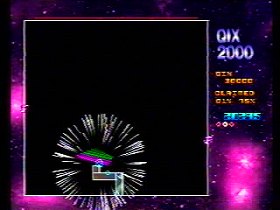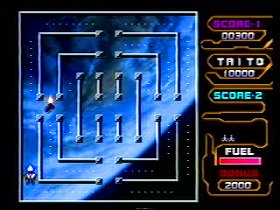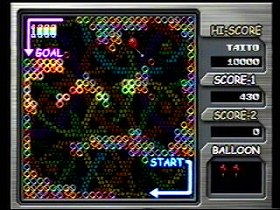
 The Game: Three classic Taito coin-ops are dragged into the modern day: the almost-text-based Crazy Balloon, the oft-copied Space Chaser (very similar to such games as Exidy’s Targ), and the abstract early ’80s classic Qix. Each game is presented with its original graphics, as well as new updated versions which – for once – just jazz up the existing 2-D graphics rather than dragging the whole mess into unnecessary 3-D. (Success Systems, 2002, for Playstation)
The Game: Three classic Taito coin-ops are dragged into the modern day: the almost-text-based Crazy Balloon, the oft-copied Space Chaser (very similar to such games as Exidy’s Targ), and the abstract early ’80s classic Qix. Each game is presented with its original graphics, as well as new updated versions which – for once – just jazz up the existing 2-D graphics rather than dragging the whole mess into unnecessary 3-D. (Success Systems, 2002, for Playstation)
Memories: Between this and the already-reviewed Space Invaders Collection, the Namco Museum series, Irem Arcade Classics and the glorious Nichibutsu Arcade Classics, you may have gotten the impression that I really, really like how the Japanese put together retro arcade compilations. And you’d be absolutely correct in that assumption. There are two big reasons for this.
- The Japanese did some great video games back in the day.
- The Japanese publishers really do seem to “get it” when it comes to these compilations. No all-new 3-D versions (though those are often available separately for those who want them, a la Crazy Climber 2000), perhaps some cosmetic change options that don’t affect game play (and let me stress again options, meaning the original game is intact for old codgers like me who want ’em), and usually a really good choice of games.
3-in-1 Arcade Classics is a good example of this phenomenon. All three titles had been previously released individually in Japan, each volume carrying both the original game and its newfangled facelift, but when you’re dealing with games whose code measures in mere K rather than megabytes, why waste all that space? (In fact, my only gripe is “why not a dozen such games? If we’re mining the Taito vaults, where are Jungle Hunt and  Front Line and Elevator Action and Zoo Keeper?”) 3-in-1 gathers the three games and their modernized versions in one place as one of the Japanese PS1 market’s now-ubiquitous “simple 1500” releases: much like the PS1 market in the U.S., Japan is seeing its share of “twilight” games released late in the console’s life span. Much like their equivalents in the U.S., these games are budget-priced, given short print runs, and are more offbeat than the PS1’s heyday, when there was pressure on every title to be a million-selling RPG, fighting game or sports sim. God bless ’em, the twilight games are much more interesting than those released when the PS1 was in its prime. It’s a damn shame they’ll probably stop doing them at the end of 2003.
Front Line and Elevator Action and Zoo Keeper?”) 3-in-1 gathers the three games and their modernized versions in one place as one of the Japanese PS1 market’s now-ubiquitous “simple 1500” releases: much like the PS1 market in the U.S., Japan is seeing its share of “twilight” games released late in the console’s life span. Much like their equivalents in the U.S., these games are budget-priced, given short print runs, and are more offbeat than the PS1’s heyday, when there was pressure on every title to be a million-selling RPG, fighting game or sports sim. God bless ’em, the twilight games are much more interesting than those released when the PS1 was in its prime. It’s a damn shame they’ll probably stop doing them at the end of 2003.
3-In-1‘s menu betrays its bargain-basement price a bit, with a no-frills list of the  three games. Once you get into each game, however, the menu is more elaborate (each menu having originated with the individual game releases), offering the original and 2000 “arrangement” versions of each title, as well as options governing background music, controller vibration, and so on.
three games. Once you get into each game, however, the menu is more elaborate (each menu having originated with the individual game releases), offering the original and 2000 “arrangement” versions of each title, as well as options governing background music, controller vibration, and so on.
Qix 2000 offers both a perfectly-translated version of the original and the insanely fun arrangement version, which updates the graphics (giving the Qix itself a Tempest X3-style psychedelic flair) and adds a few power-ups to the mix. The speed-up power-up makes even slow draw fast, and fast draw faster, but the speed-down power-up negates that effect – and heaven help you if you hit the latter while already operating at normal speed. As with just about every Qix variation since the bizarre Super Qix, claiming space on the playing field also gradually reveals an animè-style picture of a girl; I’ll never truly understand why the original Qix underwent this transformation from a game of pure geometrics to a game of revealing pictures, but hey, it really doesn’t affect the game. Letting Qix 2000 sit on its startup screen for a bit  will eventually show you the original arcade attract mode in both graphics sets (with a few Kanji subtitles here and there – Qix is a rarity in that it originated from Taito’s U.S. operation, and therefore it’s always only had on-screen instructions in English).
will eventually show you the original arcade attract mode in both graphics sets (with a few Kanji subtitles here and there – Qix is a rarity in that it originated from Taito’s U.S. operation, and therefore it’s always only had on-screen instructions in English).
Space Chaser is another instantly-addictive game in both forms, and its arrangement version is actually quite nice to look at – an example of a simple game concept which needs only a swap of its graphics set and not some kind of sweeping 3-D revamp to make it new again. There’s a reason that the Space Chaser 2000 screen shot is the one you’ll see most frequently with reference to this game: it’s an updated version of the original game superimposed over a succession of nicely-rendered space scenes.
Crazy Balloon is the one game out of this trio that I was least familiar with. Now I have to confess that I’m hooked. You guide a balloon through the tight, twisty passageways of a cavern, trying never to let the balloon come into contact with anything, lest it pop. The  original arcade game drew its caverns with asterisks, with the balloon itself being the only remotely custom-made graphical sprite in the game. Not so with the new version, though Crazy Balloon 2000 stays close to its roots. Maddening, exasperating fun!
original arcade game drew its caverns with asterisks, with the balloon itself being the only remotely custom-made graphical sprite in the game. Not so with the new version, though Crazy Balloon 2000 stays close to its roots. Maddening, exasperating fun!
3-In-1 Arcade Classics is very easily comparable to similar Japanese-market compilations from Irem and Nichibutsu – three games seems to be the magic number, as opposed to the 5-7 games that Namco squeezes into its best-of volumes, though I’d dare to say that the emulation is better on the titles bearing fewer games. Yet another version of Qix, Battle Qix, has been released by the same company for the PS1.
 It’s a pity that we had to reach the end of the PS1’s life span to get back to these instantly addictive basics, because 3-In-1 is one of the best arcade compilations for this platform; sadly, it’s also very likely the last.
It’s a pity that we had to reach the end of the PS1’s life span to get back to these instantly addictive basics, because 3-In-1 is one of the best arcade compilations for this platform; sadly, it’s also very likely the last.